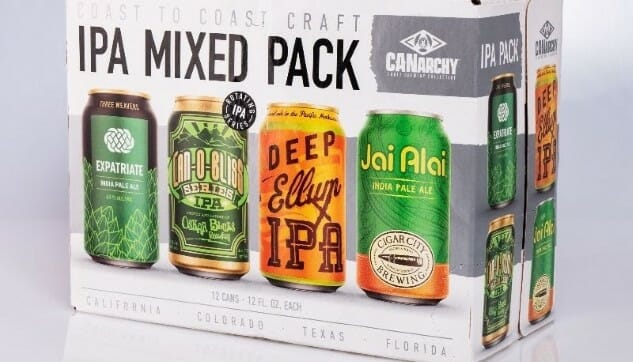Tasting the 4 IPAs in CANarchy’s New Mixed Variety Pack
Photo via CANarchy
In a craft beer market that has been feeling the pinch for the last few years, the rate of growth that continues to be experienced by brewery collective CANarchy is nothing short of incredible. The Fireman Capital-owned collection of breweries, which contains the likes of Cigar City, Oskar Blues, Deep Ellum, Three Weavers, Utah Brewers Cooperative and Perrin Brewing Co., was up almost 30 percent in total dollar sales for the year, earlier in 2019, vaulting itself to the eighth place overall position on the Brewers Association’s list of the 50 largest “craft” brewer entities. Much of this growth is still be driven by IPA (especially Cigar City’s Jai Alai, which continues to grow like gangbusters as it moves into more states), which only makes sense is the somewhat stagnant market for stylistic experimentation we’re seeing in the U.S. right now. Still—you gotta sell what people want.
Cue the release of a new mixed IPA box from CANarchy, which combines sought-after IPAs from four of the different breweries under the same ownership collective, in what has to be one of the most obvious (in hindsight) moves that any brewery group has made in recent memory. This “Coast to Coast Craft IPA Mixed Pack,” with beers from Cigar City, Oskar Blues, Three Weavers and Deep Ellum, is one of the few things about the concept of collective ownership that an average consumer could truly judge to add value or convenience to their own experience. It allows a drinker in Florida to sample beer from California or Texas alongside the ubiquitous Cigar City, and vice-versa for consumers on the West Coast. It’s simply a great idea, uncomplicated though it may be.
It also seemed to represent an obvious opportunity for me to revisit some of these beers, whether the’re ones I’ve had a million times (Cigar City), or sampled once in the distant past (Three Weavers), or have never tasted at all (Deep Ellum). And so, here are my impressions as I drank my way through the CANarchy mixed pack.
-

-

-

-

-

-

-

-

-

-

-

-

-

-

-

-

-

-

-

-

-

-

-

-

-

-

-

-

-

-

-

-

-

-

-

-

-

-

-

-








































